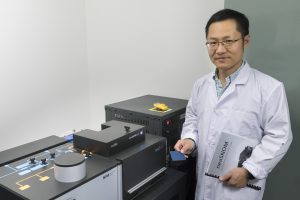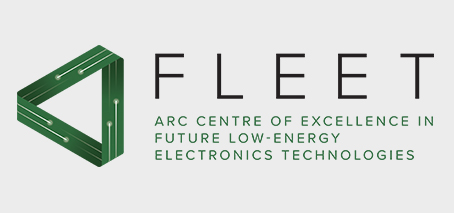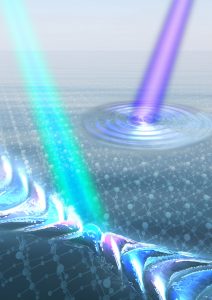An international team led by researchers from Soochow University (Suzhou, China), Monash University (Melbourne, Australia), University of Oviedo (Asturias, Spain), and CIC nanoGUNE (San Sebastián, Spain) have discovered squeezed light (‘nanolight’) in the nanoscale that propagates only in specific directions along thin slabs of molybdenum trioxide – a natural anisotropic 2D material.
Besides its unique directional character, this nanolight lives for an exceptionally long time, and thus could find applications in signal processing, sensing or heat management at the nanoscale.
Future information and communication technologies will rely on the manipulation of not only electrons but also of light at the nanometre-scale.
Squeezing (confining) light to such a small size has been a major goal in nanophotonics for many years.
A successful strategy has been the use of polaritons, which are electromagnetic waves resulting from the coupling of light and matter. Particularly strong light squeezing can be achieved with polaritons at infrared frequencies in 2D materials, such as graphene and hexagonal boron nitride.
However, although extraordinary polaritonic properties – such as electrical tuning of graphene polaritons – have been recently achieved with these materials, the polaritons have always been found to propagate along all directions of the material surface, thereby losing energy quite fast, which limits their application potential.
Recently, it was predicted that polaritons can propagate ‘anisotropically’ along the surface of 2D materials, in which the electronic or structural properties are different along different directions.
In this case, the velocity and wavelength of the polaritons strongly depend on the direction in which they propagate. This property can lead to highly directional polariton propagation in the form of nanoscale confined rays, which could find future applications in the fields of sensing, thermal heat management or maybe even quantum computing.
Now, an international team led by Qiaoliang Bao (Monash Engineering), Pablo Alonso-González (University of Oviedo, Spain) and Rainer Hillenbrand (CIC nanoGUNE, San Sebastián, Spain) have discovered ultra-confined infrared polaritons that propagate only in specific directions along thin slabs of the natural 2D material molybdenum trioxide (α-MoO3).

Qiaoliang Bao with neaSNOM microscope at MCN – the scattering-type near-field optical microscopy facility was used for polariton measurements in the study.
“Our findings promise α-MoO3 to become a unique platform for infrared nanophotonics,” says Qiaoliang Bao.
“It was amazing to discover polaritons on our α-MoO3 thin flakes travelling only along certain directions”, says Weiliang Ma, postgraduate-student and co-first-author.
“Until now, the directional propagation of polaritons has been observed experimentally only in artificially structured materials, where the ultimate polariton confinement is much more difficult to achieve than in natural materials”, adds co-first author Shaojuan Li.
Apart of directional propagation, the study also revealed that the polaritons on α-MoO3 can have an extraordinarily long lifetime.
“Light seems to take a nanoscale highway on α-MoO3; it travels along certain directions with almost no obstacles”, says Pablo Alonso-González, co-first author of the paper. He adds: “Our measurements show that polaritons on α-MoO3 live up to 20 picoseconds, which is 40 times larger than the best-possible polariton lifetime in high-quality graphene at room temperature.”
Because the wavelength of the polaritons is much smaller than that of light, the researchers had to use a particular microscope, a so-called near-field optical microscope, to image them. “The establishment of this technique coincided perfectly with the emergence of novel van-der-Waals materials, enabling the imaging of a variety of unique and even unexpected polaritons during the past years”, adds Rainer Hillenbrand.
For a better understanding of the experimental results, the researchers developed a theory that allowed them to extract the relation between the momentum of polaritons in α-MoO3 with their energy. “We have realised that light squeezed in α-MoO3 can become “hyperbolic” making the energy and wavefronts to propagate in different directions along the surface, which can lead to interesting exotic effects in optics (eg, negative refraction or ‘superlensing’),” says Alexey Nikitin, Ikerbasque Research Associate at Donostia International Physics Center (DIPC), who developed the theory in collaboration with Javier Taboada-Gutiérrez, and Javier Martín-Sánchez, PhD and postdoctoral researchers, respectively at Alonso-Gonzalez´s group.
The current work is just the beginning of a series of studies focused on directional control and manipulation of light with the help of ultra-low-loss polaritons at the nanoscale, which could benefit the development of more efficient nanophotonic devices for optical sensing and signal processing or thermal heat management.
Nanofabrication and photonics at FLEET
 Within FLEET, Qiaoliang Bao investigates waveguide-coupled 2D semiconductors and plasmon-coupled 2D materials and devices, focusing on the effect of confined-space light-matter interactions on the transport of electrons or other quasi-particles such as polaritons.
Within FLEET, Qiaoliang Bao investigates waveguide-coupled 2D semiconductors and plasmon-coupled 2D materials and devices, focusing on the effect of confined-space light-matter interactions on the transport of electrons or other quasi-particles such as polaritons.
Qiaoliang is one of almost a hundred researchers at FLEET, all motivated by one grand challenge: to reduce the energy used in information and communication technology (ICT), which already accounts for at least 8% of global electricity use, and is doubling every decade.
FLEET (the ARC Centre of Excellence in Future Low-Energy Electronics Technologies) will develop systems in which electricity flows with minimal resistance and therefore minimal wasted dissipation of energy, and devices in which this ‘dissipationless’ electric current can be switched on and off at will.
These devices will enable revolutionary new electronics and communications technologies with ultra-low energy consumption.
Published manuscript:
In-plane anisotropic and ultra-low-loss polaritons in a natural van der Waals crystal was published today in Nature; DOI: 10.1038/s41586-018-0618-9
Collaborating institutions: Soochow University (China), Monash University (Australia), University of Oviedo (Spain), Donostia International Physics Center (DIPC; Spain), CIC nanoGUNE (Spain), University of New South Wales, Sydney (Australia).
Acknowledgements
As well as FLEET funding under the Australian Research Council Centres of Excellence program, the study received significant international support, including:
- China National Natural Science Foundation of China, Youth 973 program, National Key Research Development Program, Natural Science Foundation of Jiangsu Province, Priority Academic Program Development of Jiangsu, Higher Education Institutions (PAPD) and Collaborative Innovation Center of Suzhou Nano Science and Technology
- Spain Ministry of Economy, Industry and Competitiveness, Maria de Maeztu Units of Excellence Programme.
This work was performed in part at the Melbourne Centre for Nanofabrication (MCN) in the Victorian Node of the Australian National Fabrication Facility (ANFF).
More information
- Contact A/Prof Qiaoliang Bao qiaoliang.bao@monash.edu
- Visit Monash Materials Science Monash.edu/engineering/qiaoliangbao
- Contact FLEET communications media@FLEET.org,au
- Connect @FLEETCentre
- Visit FLEET.org.au
- Watch Future solutions to computation energy use
- Subscribe FLEET.org.au/news


